
Hypothesis Testing with One-Way ANOVA - Personal Home Pages PDF
Preview Hypothesis Testing with One-Way ANOVA - Personal Home Pages
HHHHyyyyppppooootttthhhheeeessssiiiissss TTTTeeeessssttttiiiinnnngggg wwwwiiiitttthhhh OOOOnnnneeee----WWWWaaaayyyy AANNOOVVAA Statistics AArrlloo CCllaarrkk-FFooooss CCoonncceeppttuuaall RReeffrreesshheerr 1. Standardized z distribution of scores and of means can be represented as percentile rankings. 2. t distribution of means, mean differences, and ddiiffffeerreenncceess bbeettwweeeenn mmeeaannss ccaann aallll bbee ssttaannddaarrddiizzeedd, allowing us to analyze differences between 2 means 33.. NNuummeerraattoorr ooff tteesstt ssttaattiissttiicc iiss aallwwaayyss ssoommee difference (between scores, means, mean differences, or differences between means) 4. Denominator represents some measure of variability (or form of standard deviation). CCaallccuullaattiinngg RReeffrreesshheerr (cid:121) Test Statistics (cid:121) Numerator = Differences between groups (cid:121) Example: Men are taller than woman (cid:121)(cid:121) DDeennoommiinnaattoorr == VVaarriiaabbiilliittyy wwiitthhiinn ggrroouuppss (cid:121) Example: Not all men/women are the same height * There is overlap between these distributions. ( ) − μ − μ M (M ) z = M t = M σσ ss M M ⎡(M − M )−(μ − μ )⎤ (M − M ) ⎣ ⎦ t = X Y X Y = X Y s s Difference Difference AAnnaallyyssiiss ooff VVaarriiaannccee ((AANNOOVVAA)) (cid:121) Hypothesis test typically used with one or more nominal IV (with at least 3 groups overall) and an interval DV. (cid:121) tTest: Distance between two distributions (cid:121)(cid:121) FF rraattiioo:: UUsseess ttwwoo mmeeaassuurreess ooff vvaarriiaabbiilliittyy FF RRaattiioo ((SSiirr RRoonnaalldd FFiisshheerr)) between - ggroupps variance = FF within - groups variance (cid:121) Between-Groups Variance: An estimate of the population variance based on the differences aammoonngg tthhee mmeeaannss ooff tthhee ssaammpplleess (cid:121) WWiitthhiinn-GGrroouuppss VVaarriiaannccee:: AAnn eessttiimmaattee ooff tthhee population variance based on the differences within each of the three or more sample ddiissttrriibbuuttiioonnss MMoorree tthhaann ttwwoo ggrroouuppss (cid:121)(cid:121) EExxaammppllee: SSppeeeecchh rraatteess iinn AAmmeerriiccaa, JJaappaann, && WWaalleess t test? Two Sources of VVaarriiaannccee:: t test? t test? Between & Within PPrroobblleemm ooff TToooo MMaannyy TTeessttss p(A) AND p(B) = p(A) x p(B) p(A) OR p(B) = p(A) + p(B) (cid:121) TThhee pprroobbaabbiilliitty ooff aa TTyppee II eerrrroorr ((rreejjeeccttiinngg tthhee nnullll whheenn tthhee nnullll iiss true) greatly increases with the number of comparisons. Fishing Expedition “If you torture the data long enough, the numbers will prove anything you want” (Bernstein, 1996) PPrroobblleemm ooff TToooo MMaannyy TTeessttss TTyyppeess ooff AANNOOVVAA (cid:121) Always preceded by two adjectives 1. NNumbber off IInddependdentt VVariiabblles 2. Experimental Design (cid:121) OOne-WWay AANNOOVVAA: HHypothhesiis test thhat iinclluddes one nominal IV with more than two levels and an interval DV. (cid:121) Within-Groups One -Way ANOVA: ANOVA where each sample is composed of the same participants (AKA rreeppeeaatteedd mmeeaassuurreess AANNOOVVAA)).. (cid:121) Between-Groups One-Way ANOVA: ANOVA where each samplle iis composedd off ddiifffferent partiiciipants. AAssssuummppttiioonnss ooff AANNOOVVAA from 1st edition of textbook
Description: